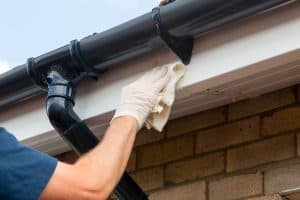Replacing Gutters Yourself: Complete Guide
If you own your home, inevitably, you will eventually have to replace your gutters. Well maintained systems can last upwards of 15 years but natural deterioration will occur, especially with a more harsh environment, like consistent heavy rains. If your gutters begin to sag or pull away from your home, you know it’s time for the update!
Improper drainage on your home can end up causing thousands of dollars in foundation repair. Good thing gutter repair and replacement costs no more than a couple of hundred dollars and a few hours of your time!
So, can you replace gutters yourself? Although gutters are often replaced by professionals, there’s really no reason you can’t do it yourself. Replacing your gutters yourself will require at least four to eight hours of time, as well as the necessary equipment and materials, which you can find at your local home center or roofing supply store.
Signs You Need To Replace Your Gutters
There are some telltale signs that you need new gutters, here are a few:
- clogging from leaves and debris
- sagging or detachment from hangers
- discoloration or rust
- leaks
- flaking paint
*it’s best to search for these signs after heavy rain when your gutters have been put to the test!

Supplies Needed to Replace Gutters Yourself
- Gutters
- Hanging brackets
- Nails
- Hammer
- Downspouts
- Corner joints
- End caps
- Pipe cutter
- Miter saw (optional)
- Level
- Flashing shingles
- Gutter sealant
- Ladder
Some safety equipment such as goggles, gloves, and a hat are also important. Click here to read our 7 tips for working safely on a roof.
Depending on your home, you may need a few other tools! Also, having a partner there to help you would be beneficial and might make the process go a little quicker.
How much do new gutters cost?
The material cost of gutters ranges from $3 to about $12 per linear foot. Aluminum and Vinyl are the most common materials used for gutters: vinyl gutters are cheaper and easier to install, but aluminum gutters will work just as well. Buying the supplies and taking on this project yourself will save you a big chunk of change in the long run. For reference, if you were to pay a contractor to install the gutters you’d be paying about an additional $10 per linear foot.
Steps For Replacing Gutters Yourself:
Before you begin, decide if you need to do a full replacement or just a few repairs. Once you decide the status of your current gutters you can move on.
Next, take down the old gutters, scrape off any old sealant and remove the old joints.
Overview your home
Be sure to overview the layout of your home and exactly where you’ll need to install the gutters and downspouts.
Layout line
You’ll want to snap a layout line with chalk before you start to ensure the gutters are level.
Attach fascia brackets
Fasten fascia brackets with stainless steel screws long enough to penetrate rafters at least 2 inches.
Size gutter
Cut gutter section to length with a saw. Pro tip: if the gutter extends around a corner, cut the appropriate angle (typically 45 degrees)
*remember, measure twice cut once!
Attach gutter end caps
At the end of the gutter, attach your end cap with pop rivets. (If the gutter doesn’t turn a corner, you can fasten an end cap at the end)
Create downspout holes
Turn the gutter on it’s back and cut the downspout hole. Typically a 4-inch-diameter hole saw in a drill will work.
Gutter install
Lay the gutter into the brackets that you’ve screwed to the fascia. then you will rotate the gutter until its back edge slips onto the hooks.
Create strip-miter joint at corners
You will need to cover the joint between the two gutters at each corner with a 3-inch-wide strip of aluminum strip miter.
Attach downspouts to gutters
Now you will secure the downspout to the gutter with pop rivets or screws.
Vinyl or Aluminum Gutters?
Vinyl gutters don’t have the durability of their aluminum counterparts but they are easier to install and will never rust. Aluminum gutters will last for over 20 years but strong winds and hail can cause damage to the aluminum. Vinyl gutters are going to cost less but could crack in cold climates.
Here is our full break down of Vinyl vs Aluminum Gutters:
Vinyl: Vinyl gutters are very easy to install and you never have to worry about them rusting. Another reason most people choose vinyl gutters has to do with the fact that it’s a more economical choice. If you are planning to take on gutter installation yourself, they’re lightweight and a lot less complicated to install. If you live in a colder climate, there is always the possibility that the vinyl could crack over time.
Aluminum: These are also a favorite since they’re lightweight and rust-proof. Another reason people tend to lean more towards aluminum gutters is the fact that they can be painted any color and they withstand all climates. If you do decide to choose aluminum gutters, it’s a good idea to go with ones that are made of primarily aluminum. If you decide on recycled aluminum they tend to be more prone to denting and bending.
Vinyl and aluminum gutters are the most popular gutter choice; however, there are many other options. Such as stainless steel, copper, and wood. Read more about the pros and cons of different gutter materials here.
Common Mistakes When Replacing Gutters at Home:
Below are five common mistakes homeowners make while replacing gutters themselves:
Choosing the wrong type of gutter:
Every home has a unique set of needs, this is why a one size fits all approach to at-home gutter installation won’t work. Before purchasing gutters it is important to take into account the amount of rainfall you receive, the pitch of your roof, and also the size of your home.
Choosing the wrong gutter size:
The basic gutter size is 5 in. long and 6 in. wide, with downspouts that are approximately 2 x 3 in. or 3 x 4 in. in length and width and 3 or 4 in. in diameter. Depending on how much rainfall and snow accumulation you receive, you may need your gutters to be larger than typical.
Not accounting for roof pitch:
All gutters should have a steep enough pitch for rainwater to flow to the downspouts. However, water can pour into the downspouts and most likely overflow if the pitch is too steep. On the contrary, if the angle is too low, water will start to sit in various parts of the gutter.
Do I need a gutter guard?:
You may be wondering if you need a gutter guard to keep leaves and other items out of your gutter. Here is a link to a guide to help you know which gutter guard is right for you.
Wrong installation of downspouts:
If downspouts are not installed properly rainwater might seep into the foundation and can cause a lot of damage. Downspouts should typically be diverting water eight to 10 feet away from your home’s foundation.
Spacing hangers too far apart:
It’s important to make sure the gutter hangers supporting the gutters aren’t spread too far apart when installing at home. If this happens, your gutters might begin to sag. In most instances, the hangers should be spaced at a maximum of three feet apart from each other. For homes in cold climates with more snowfall, the gutter hangers should be spaced a maximum of two feet apart since additional support is needed to offset the added weight of snow and ice.
Is it hard to install gutters yourself?
Professionals make a gutter installation look pretty easy, but there are actually a number of things that could go wrong. Replacing guttering is challenging and if you improperly install them you may have to call a professional to fix your error. Here are a couple of other things to take into consideration when you are replacing gutters on your own! Statistics have shown that every year thousands of homeowners fall off their ladder, and a lot of them face serious consequences. Ladder safety during at home gutter installation is very important! There are many tools involved with gutter installation, and if not used properly this can also cause very serious injuries.
In conclusion,
Replacing your home’s gutters yourself can be a huge savings, but also a huge hassle if not done correctly. Improper installation can very easily eat up the money you initially saved and increase your home insurance premiums if your home is damaged! Also, maintaining your gutters and cleaning them out at least twice a year is key to extending the life of your gutters and downspouts.
Don’t forget: you have bragging rights for completing a gutter install by yourself! Best of luck!

